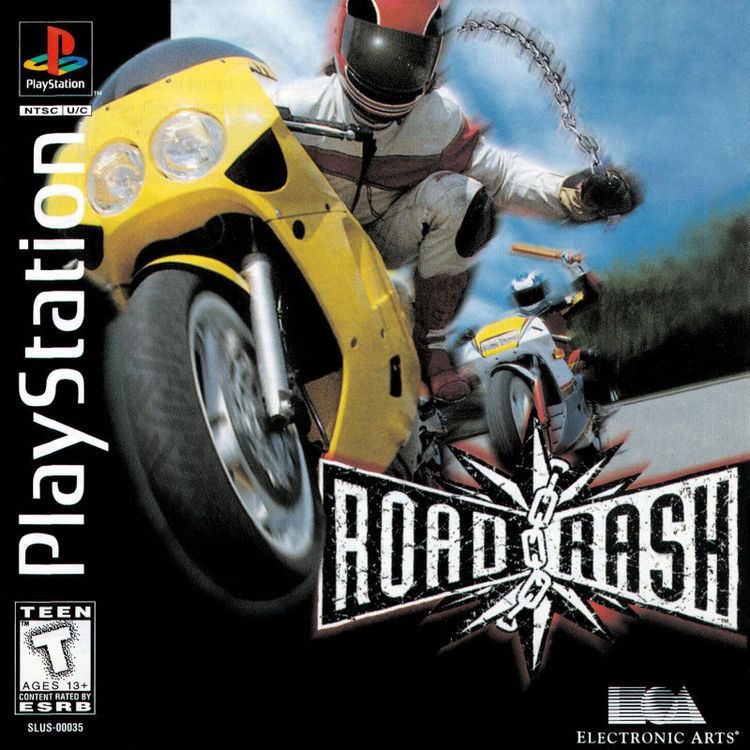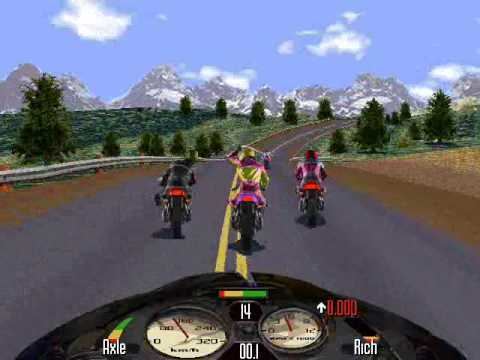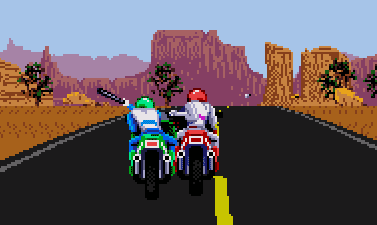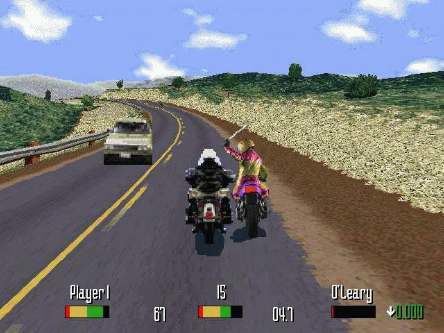7 /10 1 Votes
Initial release date 1991 Developer Electronic Arts | 3.5/5 GamesNostalgia Series Road Rash Designer Rob Hubbard | |||||||||||||||||||||||||||||||||
 | ||||||||||||||||||||||||||||||||||
Programmer(s) Dan Geisler
Walter Stein
Carl Mey Composer(s) Michael Bartlow
Rob Hubbard Genre(s) Vehicular combat, racing Mode(s) Single-player, multiplayer Platforms PlayStation, Sega Genesis, Microsoft Windows Publishers Electronic Arts, Ocean Software, U.S. Gold Similar Road Rash II, Road Rash: Jailbreak, Road Rash 3D, Road Rash 3, Road Redemption | ||||||||||||||||||||||||||||||||||
Road Rash is a vehicular combat racing video game developed and published by Electronic Arts for the Sega Genesis in 1991. It was ported to a variety of contemporary systems and was followed by five sequels.
Contents

An updated version of the game was made for a CD-based platforms such as Sega CD, 3DO, PlayStation, Sega Saturn and Microsoft Windows. It features a number of changes such as the ability to choose characters (with various starting cashpiles and bikes, some even have starting weapons) before playing, fleshed-out reputation and gossip systems and even full-motion video sequences to advance a plot. The updated version once again features all-California locales: The City, The Peninsula, Pacific Coast Highway, Sierra Nevada, and Napa Valley. The roads themselves now feature brief divided road sections.

Gameplay

The basic gameplay is similar to Sega's Hang-On (1985) and Tatsumi's Cycle Warriors (1991). The player competes in illegal road races and must finish in either 3rd or 4th place (depending on the version being played) and up in every race of a "level" in order to proceed to the next. As these levels progress, the opponents ride faster and fight harder, and the tracks are longer and more dangerous. Placing in each race gives a certain amount of money, with higher-level races offering higher payouts. This money allows the player to buy faster bikes and parts, which are needed to stay competitive, pay for repairs if the motorcycle is wrecked, or pay for fines if one is arrested by the police. The game is over if the player is unable to pay for these repairs or fines.

Road Rash requires that players contend with various grade changes. The physics reflect the act of going up or down a hill, as well as turning while climbing; this results in the ability to launch one's motorcycle great distances, resulting in crashes. Aside from this, Road Rash has a standard system of obstacles including street signs, trees, poles, and livestock. There is also active traffic while racing against other bikers.
The player character can fight other bikers with a variety of hand weapons or simple punches and kicks. The player character can grab a weapon from another rider by timing a punch correctly. The list of weapons has grown with the games, starting from the clubs in the first Road Rash, and eventually including things like crowbars, nunchaku, and cattle prods. Whatever the weapon, successful attacks damage an opponent's stamina, and depleting this stamina will cause a biker to wipeout which can also damage the bike; this functions much like hitting a car or other major obstacle, and it all applies to you as much as to other racers (though in most of the games, you have more stamina than opponents).
The motorcycle police officers fight the player as another opponent and serve as gameplay enforcers by culling players who fall too far behind or choose to explore the world rather than race in it. Losing a fight with an officer or being caught by one while off one's motorcycle causes the player to be busted, ending the race.
Soundtrack
The Sega CD, PC, and 3DO game's soundtracks contained 14 music tracks from A&M Records artists Soundgarden, Paw, Hammerbox, Therapy?, Monster Magnet, and Swervedriver. Months before Road Rash was even released, it received 3DO's 1994 "Soundtrack of the Year" award.
The Sega CD port is unique in the series in that it is the only one which plays the artists' soundtracks during racing, as well as throughout the game. The 3DO port and later versions reverted to using generic synthesized music while racing, and the artists' soundtracks within the menus and intros.
Cancelled SNES port
It was announced that THQ would publish a Super NES version of Road Rash sometime in 1996, but the release was later cancelled.
Reception
MegaTech magazine said "Lots of races, lots of bikes, and plenty of thrills 'n' spills make this the best racer on the Megadrive!" Computer and Video Games praised it for being like a "beat 'em up on motorbikes" and "Super Hang-On with fists and clubs thrown in". The Mega Drive version received a very favorable review in Mean Machines magazine. It received a final score of 91% and was praised for its music, graphics and gameplay. Mega placed the game at #8 on their Top Mega Drive Games of All Time. Game Informer ranked it as the 88th best game ever made in their 100th issue in 2001. The staff praised its more violent take on motorcycle video games.
The Commodore Amiga release of Road Rash received moderately high ratings, including 84% from Amiga Format and 81% from CU Amiga. The release received a lower score from Amiga Power, who rated the game a 70/100. It won several awards from Electronic Gaming Monthly in their 1994 video game awards, including Best Driving Game, Best Music in a CD-Based Game, and Best 3DO Game of 1994. The PC version was also a top-seller in its first year of release.
GamePro gave the 3DO version a perfect score, citing improvements such as the five new tracks, six lane roads, branching routes, digitized backgrounds, humorous full motion video sequences, and new rock soundtrack. They concluded that "This souped-up Road Rash will knock the socks off experienced rashers and new racers alike." Their one criticism was the lack of a multiplayer option. The two sports reviewers of Electronic Gaming Monthly gave the 3DO version scores of 83% and 85%, declaring it a vast improvement over the Genesis Road Rash games due to the advanced graphics, high playability, and "the coolest music in gaming". However, one of them also criticized that the gameplay eventually becomes repetitive. GamePro gave the Sega CD version a mostly positive review, remarking that though it is a major letdown compared to the 3DO version, it is impressive compared to other Genesis/Sega CD racers. A reviewer for Next Generation also remarked that the Sega CD version is a major step down, and that while most of the downgrades are forgivable due to the Sega CD being a much less powerful system than the 3DO, the sparse scenery and low frame rate do not hold up even to games on the same system. He concluded it to be decent but less than what gamers would expect from the by-then established Road Rash series.
The PlayStation version was somewhat less well-received than previous versions. Reviewers for Electronic Gaming Monthly, Next Generation, and Maximum all criticized it for being a port of the 3DO version with only minor enhancements to the graphics and sound, with no changes to the gameplay which had become outdated and outclassed by more recent racing games in the four years since Road Rash was first released. GamePro, however, felt that the gameplay remained exciting, and though they remarked that the controls are stiffer than on previous versions, they gave the PlayStation version a wholehearted recommendation.
